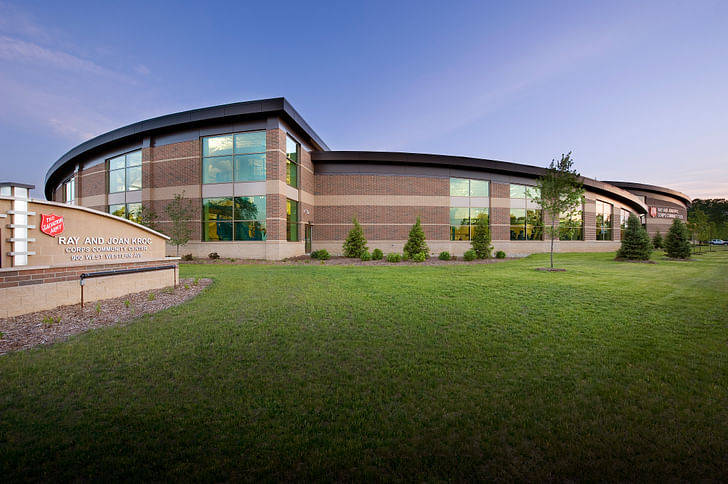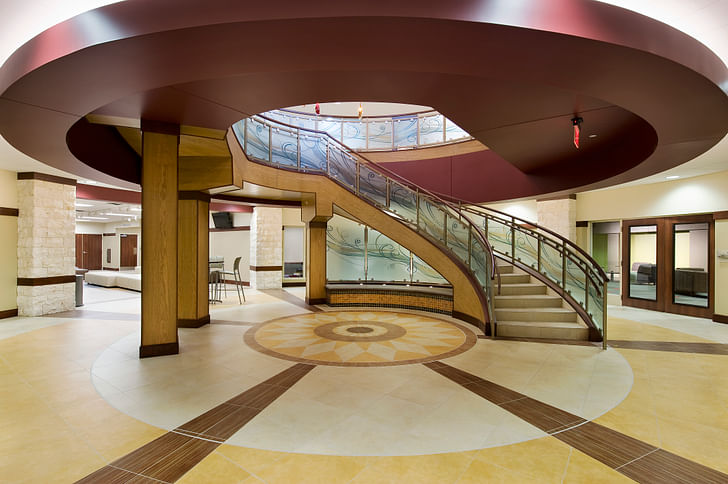

This month, in line with Archinect’s December theme, Faith, we’re talking to architects of various faiths about how their spiritual practice figures into their architectural practice. In this iteration, we speak with LeRoy Troyer, the president and chair of Troyer Group. Troyer Group is probably best-known for their project “Ark Encounter”, a full-scale replica of Noah’s Ark, built according to plans interpreted from Genesis.
Troyer is a nondenominational Christian who attends an Anabaptist church. Archinect spoke recently with Troyer Group about their work on the Ark Encounter, but they’re also known for a wide variety of other projects, both religious and secular. Troyer Group has designed faith-based spaces for a variety of religious denominations, including Methodists, Baptists, Presbyterians, and Roman Catholics. Notable projects include the First Presbyterian Church is Mishawaka, Indiana, the Community Baptist Church in South Bend, Indiana, and the First Presbyterian Church in Goshen, Indiana. For LeRoy Troyer, each project amounts to an exercise in faith.
most of my life I’ve said I’d like to contribute, to use the creativity that God gave us“Basically most of my life I’ve said I’d like to contribute, to use the creativity that God gave us,” states Troyer. “I use [biblical accounts] basically as principles to create environments that are enjoyable for people to use and impart benefit.”
Raised in the Amish community, Troyer had an early introduction to architecture via one of his teachers, who one day brought drawings and blueprints into the classroom. Unlike many young architecture students today, Troyer had hands-on experience before receiving a formal education. When a tornado or a fire would destroy a building on the farm where he was raised, he would help rebuild it. Troyer quit school at 16 and went straight into construction, where he also learned architectural drafting. Then he continued to work with firm contractors for about five years.


“I did drawings throughout the evenings, during the day I’d help build the buildings I was doing the drawings [for],” states Troyer. “I started at the very bottom and just worked my way up in a matter of a few years.”
Troyer then attended the University of Notre Dame, graduating at the age of 32 with a degree in architecture. He passed his boards the same year and immediately opened his own office. But before graduating, Troyer helped organize a United Nations conference for young people oriented around the human environment. For Troyer, preserving and caring for the environment are central to his spiritual practice.We know that we are impacted by our environment
“We know that we are impacted by our environment, it has much to do with our health, our wellbeing, our outlook on life, how we respond to things in our life, and that’s a continuing factor,” he states.
When it comes to secular projects, Troyer explains that religion still affects the way he approaches a building. That is to say, concern for the experience and well-being of those who inhabit the building are central to his practice. Designing places of worship, on the other hand, poses different sorts of challenges.

“I was asked one time, one church said, ‘We want you to design a building where it’s a sacred holy place,’ and I said, ‘I don’t really know how to do that,’ because God promises that he wants us, he wants us and our heart, he wants to live in us...Basically what is created is more sacred than what we can necessarily design and build.”
It’s a question of treating and respecting sacred spaceTo that end, Troyer favors religious buildings that have a strong relationship to their external setting. In particular, he named the Thorn Crown Chapel in Eureka Springs, Arkansas as a favorite. The small chapel features massive windows out to the bucolic forest setting surrounding it.
“That’s one of the most unique buildings for worship that I’ve ever been in,” states Troyer.
“It’s a question of treating and respecting sacred space,” he states. “I think spaces are generally more sacred before we touched it than afterwards. That’s the land.”

This article is part of Archinect's special December theme, Faith. Stay tuned for more on the relationship between faith and practice.
Check out more images of faith-based projects by Troyer Group in the gallery below.
Writer and fake architect, among other feints. Principal at Adjustments Agency. Co-founder of Encyclopedia Inc. Get in touch: nicholas@archinect.com
4 Comments
So, he's ok with working on a large land-locked boat housing only ignorance and very unfortunate children visitors?
Pass.
No intellectual value here.
Im sure he voted for Donald Duck
The podcast interview with Mr. Troyer (linked above) was IMO one of the best 1:1s. He knows the challenges of practice really well and brings up questions regarding the ethical practice of architecture that are relevant for anyone in our field, regardless of religion.
Contrast the statements by Mr. Troyer in this article with those of Mr. Rotondi in another. Mr. Troyer is very careful not to make extraordinary claims. He does not mention any mash up of science, intuition, spirituality or other pseudo-facts as the design process. If he would approve of ("Rotondi-ism"), he seems to be keeping it private or leaving it to others. Perhaps that is inside as interiors, exhibits or just left to interpretation. He is being a bit dishonest in alluding to the fact the he needs to look at other things beyond "the experience" and "well-being" of the inhabitants when designing a non-secular building. I am sure he would agree that whatever special considerations where required for a purely religious building (or place of prayer) could be achieved by purely secular means. I may be putting words in his mouth, but by simply acknowledging his preference for nature (and the site) as a key "other thing", he leaves a door open without asserting anything spiritual, or fallacious is required. There is no mention of mentoring students in his process or approach as well. That is important to me and key. He seems to let the work stand by itself without much angst in attaining it. Having said all that, The Ark thing is at best, a very very bad Disneyland. At worst, a really odd thing masquerading as a museum or place of knowledge. However, we have a couple of those here in New York too. Madame Tussaud's, Ripley's Believe it or Not, The Museum of Sex, and in nearby Washington DC, "The Newseum". These places are really the same sort of thing. As Architecture a couple are executed pretty well. I will not tell you which I like best. But for each, the contents are, well ... lets just say entertaining, odd or misleading. I doubt Mr. Troyer has much to do with the exhibits at the Ark. If he did provide input on the construction, perhaps kudos is due. The wood construction is painfully interesting and well executed, like a visiting the Queen Mary and suddenly realizing she will never brave the salty waves of Noreaster while leaving the wine glasses in place again. Perhaps he feels the same but cannot admit it. I like to think so. I do not speak for Mr. Troyer but the contrast in the two articles and statements by the Architect's is noted by me.
Block this user
Are you sure you want to block this user and hide all related comments throughout the site?
Archinect
This is your first comment on Archinect. Your comment will be visible once approved.